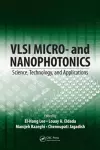
VLSI Micro- and Nanophotonics
4 contributors - Hardback
£180.00
Professor El-Hang Lee graduated from Seoul National University with a BSEE (summa cum laude) in 1970. He received his MS, MPhil, and Ph.D in applied physics from Yale University in 1973, 1975, and 1977, respectively, under the guidance of Professor John B. Fenn (Yale, Nobel Laureate, chemistry, 2002) and Professor Richard K. Chang (Henry Ford II Professor, former student of Professor N. Bloembergen, Harvard, Nobel Laureate, physics, 1981). Professor Lee subsequently conducted teaching, research, and management in the fields of semiconductor physics, materials, devices, optoelectronics, photonics, and optical communication at Yale University, Princeton, MEMC, AT&T, ETRI (Electronics and Telecommunications Research Institute; vice president), and KAIST (Korea Advanced Institute of Science and Technology). In 1999, Professor Lee joined INHA University, where he has been a distinguished university professor, founder of the School of Information and Communication Engineering, dean of the Graduate School of Information Technology, founding director of the micro/nano-PARC (Photonics Advanced Research Center), and founding director of the OPERA (Optics and Photonics Elite Research Academy) National Research Center of Excellence for VLSI Photonics.
Dr. Louay Eldada is the chief technology officer of HelioVolt Corporation, Austin, Texas, where he leads the development and manufacture of compound semiconductor-based photovoltaic modules and systems. He holds a PhD from Columbia University, specializing in optoelectronic devices, modules, and systems. Dr. Eldada started his professional career with Honeywell International, where he founded the Telecom Photonics venture and directed its research and development arm for six years. The group’s success led to its acquisition by Corning Inc., where he continued to manage technical development. After leaving Corning Inc., Dr. Eldada founded Telephotonics Inc., a start-up company, where he took on the responsibilities of chief technical officer and vice president of engineering for the development and manufacture of innovative organic–inorganic highly integrated optoelectronic integrated circuits and systems. The commercial success of Telephotonics, Inc. in two years after its launch led to its acquisition by E. I. du Pont de Nemours and Company (DuPont)®, where Dr. Eldada served as chief technical officer and vice president of engineering at DuPont Photonic Technologies for six years.
Professor Manijeh Razeghi (fellow, IEEE) is one of the leading scientists in the field of semiconductor science and technology, and a pioneer in the development and implementation of major modern epitaxial techniques. She received her Doctorat d’Etat es Sciences Physiques from the Universite de Paris, France, in 1980. After receiving her doctoral degree, she joined Thomson-CSF (Orsay, France) as a senior research scientist and then served as the head of the Exploratory Materials Laboratory from 1980 to 1991. She joined Northwestern University, Evanston, Illinois, as a Walter P. Murphy Professor and Director of the Center for Quantum Devices in the fall of 1991, where she created the undergraduate and graduate programs in solid-state engineering. Her current research interest is in nanoscale optoelectronic quantum devices. She is a past recipient of the IBM Europe Science and Technology Prize.
Professor Chennupati Jagadish was born and educated in India and worked there and in Canada prior to moving to Australia in 1990. He is currently a federation fellow, professor, and head of the Semiconductor Optoelectronics, Nanotechnology and Photovoltaics Group in the Research School of Physical Sciences and Engineering, Australian National University. He is also the convenor of the Australian Research Council Nanotechnology Network, the director (ACT Node) of the Australian National Fabrication Facility, and the president of the IEEE Nanotechnology Council (NTC). He is the recipient of the 2000 Institute of Electrical and Electronics Engineers, Inc. (IEEE) Millennium Medal and has received distinguished lecturer awards from both the IEEE Lasers and Electro-Optics Society and the IEEE Electron Devices Society.